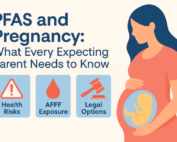Summary of the Lawsuit
On June 4, 2024, the City of Ceiba, Puerto Rico, filed a significant lawsuit against several major chemical manufacturers, including 3M Company, AGC Chemicals Americas Inc., and DuPont de Nemours Inc. This legal action, lodged in the United States District Court for the District of Puerto Rico, seeks to address the extensive environmental and health damages caused by the release of per- and polyfluoroalkyl substances (PFAS) through the use of Aqueous Film-Forming Foam (AFFF).
PFAS, often referred to as “forever chemicals” due to their persistence in the environment and human body, are synthetic chemicals linked to severe health issues, including cancer and hormone disruption. This article provides a detailed overview of the lawsuit, the defendants involved, the allegations made, and the broader implications for environmental and public health.
Background of the Case
Parties Involved
Plaintiff
▪ City of Ceiba, Puerto Rico
Defendant(s)
▪ 3M Company (formerly Minnesota Mining and Manufacturing Company)
▪ AGC Chemicals Americas Inc.
▪ Amerex Corporation
▪ Archroma U.S. Inc.
▪ Arkema, Inc.
▪ BASF Corporation
▪ Buckeye Fire Equipment Company
▪ Carrier Fire & Security Americas Corporation
▪ ChemDesign Products, Inc.
▪ Chemguard, Inc.
▪ Chemicals, Inc.
▪ Chubb Fire, Ltd.
▪ Clariant Corp.
▪ Corteva, Inc.
▪ Daikin America, Inc.
▪ Deepwater Chemicals, Inc.
▪ DuPont de Nemours Inc.
▪ Dynax Corporation
▪ E.I. DuPont de Nemours and Company
▪ Johnson Controls, Inc.
▪ Kidde PLC
▪ Nation Ford Chemical Company
▪ National Foam, Inc.
▪ Perimeter Solutions LP
▪ The Chemours Company
▪ The Chemours Company FC, LLC
▪ Tyco Fire Products LP
▪ United Technologies Corporation
▪ UTC Fire & Security Americas Corp., Inc.
Summary of the Allegations
Environmental and Health Damages
The lawsuit alleges that the defendants’ manufacturing, marketing, and distribution of AFFF, which contains PFAS, have led to widespread environmental contamination and significant health risks. PFAS compounds, including PFOA and PFOS, are particularly noted for their persistence in the environment and their harmful effects on human health. These chemicals are highly soluble in water and resistant to biodegradation, leading to long-term contamination of soil, water, and biota.
Key Points of Contamination
- Municipal Water Supply: The City of Ceiba’s water supply has been contaminated with PFAS due to the use of AFFF at nearby military and civilian firefighting sites, including Jose Aponte Hernandez Airport and the former Roosevelt Roads Naval Station.
- Soil and Sediment: PFAS have migrated through the soil and into the groundwater, contaminating municipal lands and natural resources.
- Biota: The contamination has affected local flora and fauna, with PFAS found in various species, potentially entering the food chain and impacting human health.
Defendants’ Conduct
The complaint asserts that the defendants were aware of the toxic nature of PFAS since the 1960s but failed to take appropriate measures to mitigate the environmental and health risks. Despite knowing the harmful effects, the defendants continued to produce and market AFFF without adequate warnings, leading to widespread contamination.
Legal Causes of Action
Negligence
The City of Ceiba claims that the defendants were negligent in their duty of care by designing, manufacturing, and distributing a product known to be harmful. The lawsuit argues that the defendants’ actions were reckless, given their knowledge of the dangers posed by PFAS.
Public and Private Nuisance
The contamination of municipal lands and resources is framed as both a public and private nuisance. The defendants’ actions are alleged to have significantly interfered with the public’s right to a clean and safe environment, causing substantial harm to the community’s health and well-being.
Trespass
The defendants are accused of trespassing by allowing PFAS to infiltrate the City’s property without consent. This unauthorized entry has resulted in significant environmental damage and health risks.
Breach of Warranty
The lawsuit also includes claims of breach of warranty, asserting that the defendants sold and distributed AFFF under the pretense that it was safe, despite knowing its toxic properties.
Broader Implications
Environmental Impact
The widespread use of AFFF containing PFAS has led to significant environmental contamination across numerous military and civilian sites. The persistence and bioaccumulative nature of PFAS compounds mean that they remain in the environment for extended periods, causing long-term ecological damage. This case highlights the need for stringent regulations and oversight in the manufacturing and use of such chemicals.
Public Health Concerns
PFAS exposure has been linked to various health issues, including cancer, thyroid disease, and immune system dysfunction. The lawsuit underscores the potential public health crisis posed by these chemicals, necessitating urgent action to address contamination and mitigate risks to human health.
Corporate Accountability
This lawsuit, and many others like it, emphasizes the importance of corporate responsibility in environmental stewardship. The defendants’ alleged failure to disclose the risks associated with PFAS and to implement measures to prevent contamination reflects a broader issue of corporate negligence. Holding these companies accountable could set a precedent for future environmental litigation and drive more responsible business practices.
Analysis and Expectations
Expected Outcomes
- Likely to Settle: Given the historical context of similar lawsuits, it is likely that the defendants will opt for a settlement to avoid prolonged litigation and negative publicity. Settlements often occur when the evidence against the defendants is substantial, which appears to be the case here, given the documented knowledge of PFAS’s harmful effects and the extensive contamination.
- Potential Settlement Amounts: Settlement amounts in cases involving widespread environmental contamination and public health risks can vary significantly. However, considering the severity of the allegations and the potential for long-term environmental and health impacts, settlements could range from tens to hundreds of millions of dollars. For instance, in previous PFAS-related cases, settlements have reached substantial figures, with some companies agreeing to pay over $850 million to resolve claims.
- Litigation Timeline: If the case proceeds through litigation rather than settlement, the timeline could extend over several years. The discovery phase alone, where both sides gather evidence, could take 1-2 years. Following discovery, if the case goes to trial, it could add another 1-2 years, depending on the complexity of the case and the court’s schedule.
- Regulatory and Policy Changes: Beyond financial compensation, this lawsuit may spur regulatory and policy changes. Increased scrutiny on PFAS and AFFF could lead to stricter regulations governing the use of these chemicals, mandatory reporting of PFAS levels in water supplies, and enhanced cleanup efforts for contaminated sites.
Broader Impacts on Industry and Environment
- Industry-Wide Repercussions: The outcome of this lawsuit could have far-reaching implications for the chemical and manufacturing industries. Companies may be required to invest in safer alternatives to PFAS, improve transparency about chemical use, and adopt more rigorous environmental protection measures. Additionally, the financial burden of settlements and fines could drive companies to prioritize environmental compliance to avoid similar legal challenges.
- Environmental Remediation Efforts: Successful litigation or settlement will likely include provisions for environmental remediation. Funds from settlements could be allocated to clean up contaminated sites, restore affected ecosystems, and ensure safe drinking water for impacted communities. This could set a precedent for future environmental lawsuits, emphasizing the importance of holding polluters accountable for remediation efforts.
- Public Awareness and Advocacy: High-profile lawsuits such as this one raise public awareness about the dangers of PFAS and the need for corporate accountability. Increased public scrutiny can lead to stronger advocacy for environmental protection and influence policymakers to implement stricter regulations. Public pressure may also encourage companies to adopt more sustainable practices and reduce their environmental footprint.
Corporate Accountability
This lawsuit, and many others like it, emphasizes the importance of corporate responsibility in environmental stewardship. The defendants’ alleged failure to disclose the risks associated with PFAS and to implement measures to prevent contamination reflects a broader issue of corporate negligence. Holding these companies accountable could set a precedent for future environmental litigation and drive more responsible business practices.
Conclusion
This lawsuit filed by the City of Ceiba, Puerto Rico, against major chemical manufacturers is one of many lawsuits that represent a critical step in addressing the environmental and health impacts of PFAS contamination. As the case progresses, it will shed light on the pervasive issue of “forever chemicals” and their long-term consequences for communities and ecosystems. This legal action underscores the need for enhanced regulatory frameworks, corporate transparency, and proactive measures to protect public health and the environment from hazardous substances.
The expected outcomes of this case, including potential settlements and regulatory changes, highlight the broader implications for the industry and environment. By holding companies accountable, this lawsuit could drive significant improvements in environmental stewardship and public health protection, setting a precedent for future litigation and advocacy efforts






